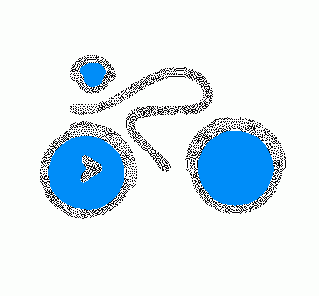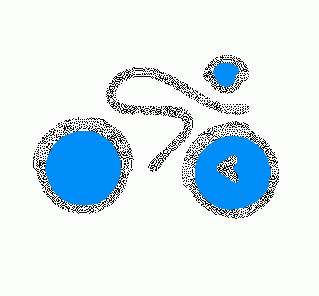| Newsletter - 2014 Archive |
 |
Cycling Club |
 |
| Newsletter - 2014 Archive |
 |
Cycling Club |
 |
Next--->
|
Define Your Focus: Lessons from Lon I'm sitting across the table from the man who owns one half of the transcontinental tandem speed record. He's just told us the key to maximizing efficiency when standing on the pedals of a tandem -- "You've got keep a light grip on the bars and treat it like a unicycle with no seat(!)"--and now he's sharing an example of how that works by relating his first test ride as a stoker on the record setting tandem with Pete Penseyres. Apparently they were coming to a rise and Pete announced that they would get up on a three count to test out their balance standing on the pedals. When Lon Haldeman told Pete he was already standing Pete simply said, "I think we're going to be ok." And they were. Lon and Pete were almost equally powerful riders who would swap spots on the bike and who climbed hills in a 56 or a 48 tooth chainring. The two of them were also smooth enough to not 27 years after that record setting run, Lon still has an even-keel personality and a deadpan sense of humour that even a neophyte endurance cyclist like myself can recognize would serve one well in the inevitable moments of stress that arrive in an ultra distance record setting attempt. Five of us are eating dinner at a chain restaurant in a mall parking lot across the street from our hotel in Sierra Vista, Arizona. It' the second day of Lon and his wife Susan's PAC Tours Desert Camp and I feel like I'm in his support van or on one of his training rides as tells us about some of his experiences. When I ask him if PAC Tours sells their experience as a support crew Race Across America (RAAM) racers he says that it would have to be a special case of someone he wanted to help and it wouldn't be for money. Crewing for a RAAM competitor is extremely stressful and the relationship is skewed too much if money changes hands. "It's like when they were trying to get people like Greg Lemond and others to do RAAM in the 80's for $100,000. Somebody asked me how much it would cost to get me to do it. I just said,'You couldn't pay me enough to do that race...so I'll do it for free." Then he tells us about crewing for RAAM in the past and how racers go through strange mental states and you need to be able to speak frankly to snap them out of it--something that is hard to do when they are technically your boss. "The racer will be sitting there, more than halfway through the race, insisting that we have to change their handlebar tape because the colour is bothering them. I have to say, Look, you need to define your focus here. Why are you doing this?!?" Define your focus. I'm temporarily stunned. It seems like such as simple way to remind someone (or yourself!) that he/she is not seeing the forest for the trees and I hope I can take that one with me for my entire life, not just those times in a ride or brevet when I start to get antsy. Wondering about the predictability of these type of meltdowns, I tell Lon about how I had warned Malou about that the 120km mark of her first 200km brevet might be a low point because that's where I tend to feel lousy and ask him if he ever experienced the same thing. Lon affirms this is a real phenomenon and he calls it,'The 2/3 Rule'. "You are far enough along that you know you will probably finish so you lose focus. We would tell ourselves that a ride like RAAM wasn't over until we had unpacked the van in the garage back home. That way if you have a 2/3 meltdown on the drive home it doesn't affect your race." Dinner ends and we walk back to the hotel together for the Desert Camp nightly program. Fred Matheny is going to talk about what type of bike one should use on a PAC Tour and after Fred describes my single rando bike perfectly, he hands it over to Lon who says you also need a little mechanical know-how to survive a PAC Tour or an event like PBP. "At minimum, you need to be able to do three things: Thanks to Lon himself I had learned earlier in the day how to replace a Campy shifter cable (and I even managed to do it without taking off the bar tape!). I have learned to true wheels working on my students' department store bikes in the school bike club and, of course, recent rides have galvanized the flat tire repair drill. I leave the seminar feeling pretty good about my bike set up and repair skills and eager to work on tandem handling. For the rest of the week at Desert Camp Malou and I work on hovering above the seat and keeping a light grip on the hoods when standing--riding that,"unicycle with no seat." We can't hold it for very long at this point since it requires more core strength but (and I could just be imagining) it seems like we can juice a little more power over the tops of the rollers. We are not quite ready for her to take naps on the longer downhills but maybe we'll have that down by the end of the Spring Series! Having signed up for the VanIsle 1200, our focus for all future rides this year has been defined. We will be riding to build and learn for our first tandem 1200. Thanks Lon!
March 31, 2014 |